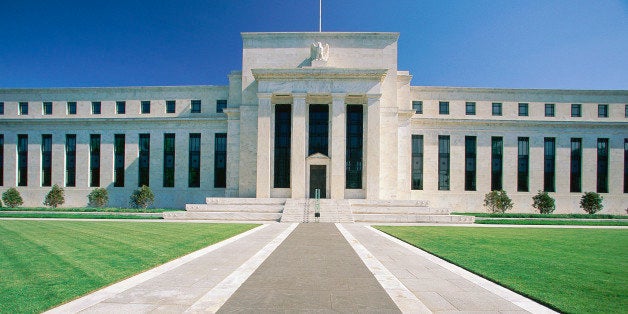
December 23, 2013, marks the 100th anniversary of the Federal Reserve, warranting a review of its performance. Has it achieved the purposes for which it was designed?
The answer depends on whose purposes we are talking about. For the banks, the Fed has served quite well. For the laboring masses whose populist movement prompted it, not much has changed in a century.
Thwarting Populist Demands
The Federal Reserve Act was passed in 1913 in response to a wave of bank crises, which had hit, on average, every six years over a period of 80 years. The resulting economic depressions triggered a populist movement for monetary reform in the 1890s. Mary Ellen Lease, an early populist leader, said in a fiery speech that could have been written today:
Wall Street owns the country. It is no longer a government of the people, by the people, and for the people, but a government of Wall Street, by Wall Street, and for Wall Street. The great common people of this country are slaves, and monopoly is the master ... Money rules ... Our laws are the output of a system which clothes rascals in robes and honesty in rags. The parties lie to us and the political speakers mislead us...
We want money, land and transportation. We want the abolition of the National Banks, and we want the power to make loans direct from the government. We want the foreclosure system wiped out.
That was what they wanted, but the Federal Reserve Act that they got was not what the populists had fought for, or what their leader William Jennings Bryan thought he was approving when he voted for it in 1913. In the stirring speech that won him the Democratic presidential nomination in 1896, Bryan insisted:
[We] believe that the right to coin money and issue money is a function of government ... Those who are opposed to this proposition tell us that the issue of paper money is a function of the bank and that the government ought to go out of the banking business. I stand with Jefferson ... and tell them, as he did, that the issue of money is a function of the government and that the banks should go out of the governing business.
He concluded with this famous outcry against the restrictive gold standard: "You shall not press down upon the brow of labor this crown of thorns, you shall not crucify mankind upon a cross of gold."
What Bryan and the populists sought was a national currency issued debt-free and interest-free by the government, on the model of Lincoln's Greenbacks. What the American people got was a money supply created by private banks as credit (or debt) lent to the government and the people at interest. Although the national money supply would be printed by the U.S. Bureau of Engraving and Printing, it would be issued by the "bankers' bank," the Federal Reserve. The Fed is composed of twelve branches, all of which are 100 percent owned by the banks in their districts. Until 1935, these branches could each independently issue paper dollars for the cost of printing them, and could lend them at interest.
1929: The Fed Triggers the Worst Bank Run in History
The new system was supposed to prevent bank runs, but it clearly failed in that endeavor. In 1929, the United States experienced the worst bank run in its history.
The New York Fed had been pouring newly-created money into New York banks, which then lent it to stock speculators. When the New York Fed heard that the Federal Reserve Board of Governors had held an all-night meeting discussing this risky situation, the flood of speculative funding was retracted, precipitating the 1929 stock market crash.
At that time, paper dollars were freely redeemable in gold, but banks were required to keep sufficient gold to cover only 40 percent of their deposits. When panicked bank customers rushed to cash in their dollars, gold reserves shrank. Loans then had to be recalled to maintain the 40 percent requirement, collapsing the money supply. To stop the collapse of the money supply, in 1933 Roosevelt made the very controversial move of taking the dollar off the gold standard within the United States.
The result of the banking crisis was widespread unemployment and loss of homes and savings, similar to that seen today. In a scathing indictment before Congress in 1934, Representative Louis McFadden blamed the Federal Reserve. He said:
Mr. Chairman, we have in this Country one of the most corrupt institutions the world has ever known. I refer to the Federal Reserve Board and the Federal Reserve Banks ...
The depredations and iniquities of the Fed has cost enough money to pay the National debt several times over...Some people think that the Federal Reserve Banks are United States Government institutions. They are private monopolies which prey upon the people of these United States for the benefit of themselves and their foreign customers; foreign and domestic speculators and swindlers; and rich and predatory money lenders.
These 12 private credit monopolies were deceitfully and disloyally foisted upon this Country by the bankers who came here from Europe and repaid us our hospitality by undermining our American institutions.
The Fed Agrees to Return the Interest
For its first half century, the Federal Reserve continued to pocket the interest on the money it issued and lent to the government. But in the 1960s, Wright Patman, Chairman of the House Banking and Currency Committee, pushed to have the Fed nationalized. To avoid that result, the Fed quietly agreed to rebate its profits to the U.S. Treasury.
In The Strange Case of Richard Milhous Nixon, published in 1973, Congressman Jerry Voorhis wrote of this concession:
It was done, quite obviously, as acknowledgment that the Federal Reserve Banks were acting, on the one hand, as a national bank of issue, creating the nation's money, but on the other hand, charging the nation interest on its own credit -- which no true national bank of issue could conceivably, or with any show of justice, dare to do.
Rebating the interest to the Treasury was clearly a step in the right direction. But the central bank funded very little of the federal debt. Commercial banks held a large chunk of it and as Voorhis observed, "[W]here the commercial banks are concerned, there is no such repayment of the people's money."
Commercial banks did not rebate the interest they collected to the government, said Voorhis, although they also "'buy' the bonds with newly created demand deposit entries on their books -- nothing more."
Today the proportion of the federal debt held by the Federal Reserve has shot up, due to repeated rounds of "quantitative easing." But the majority of the debt is still funded privately at interest, and most of the dollars funding it originated as "bank credit" created on the books of private banks.
Time for a New Populist Movement?
The Treasury's website reports the amount of interest paid on the national debt each year, going back 26 years. At the end of 2013, the total for the previous 26 years came to about $9 trillion on a federal debt of $17.25 trillion. If the government had been borrowing from its own central bank interest-free during that period, the debt would have been reduced by more than half. And that was just the interest for 26 years. The federal debt has been accumulating ever since 1835, when Andrew Jackson paid it off and vetoed the Second U.S. Bank's renewal -- and all that time it has been accruing interest. If the government had been borrowing from its central bank all along, it might have had no federal debt at all today.
In 1977, Congress gave the Fed a dual mandate, not only to maintain the stability of the currency, but to promote full employment. The Fed got the mandate but not the tools, as discussed in my earlier article.
It may be time for a new populist movement, one that demands that the power to issue money be returned to the government and the people it represents; and that the Federal Reserve be made a public utility, owned by the people and serving them. The firehose of cheap credit lavished on Wall Street needs to be re-directed to Main Street.
